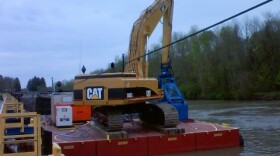The federal Environmental Protection Agency held a public meeting Wednesday night in Poughkeepsie concerning PCB cleanup in the Hudson River. Several people in the packed room called for more cleanup.
Before the EPA meeting, Scenic Hudson and Riverkeeper held a rally a few blocks away.
“People, birds, fish and otters, PCBs pollute our waters.” (twice)
Scenic Hudson President Ned Sullivan says EPA must order General Electric to finish cleaning up the Hudson.
“We made progress, but EPA is now saying they want Mother Nature to finish the job. That means that thousands and thousands of pounds of PCBs in the upper Hudson are going to continue to flow down into the lower Hudson, to the mid Hudson, to New York Harbor, contaminating our sediments, our drinking water, making the fish unsafe to eat and the air unsafe to breathe,” Sullivan says. “EPA has the power, the authority to get GE to finish the job.”
The EPA released its second review of the cleanup of PCBs from the upper Hudson River June 1. The review concludes that the $1.7 billion cleanup of the Superfund site is working. General Electric removed 2.65 million cubic yards of contaminated sediment from a 40-mile stretch of the upper Hudson through 2015. Gary Klawinski is director of the EPA’s Hudson River office.
“The five-year review is narrowly focused. It’s not about us making a decision about more dredging or not. It’s us evaluating, EPA evaluating, the protectiveness of the remedy given that we just did this comprehensive cleanup of the upper Hudson River and we want to see how the recovery’s occurring after the dredging.”
Poughkeepsie Mayor Rob Rolison attended the rally and says he was glad EPA held the meeting in his city, which gets its drinking water from the Hudson.
“I will support and advocate for anything that makes sure that we have quality drinking water in this region and protects not only that but also protects a large economic engine called the Hudson River,” Rolison says.
Rolison, who sits on the joint water board that governs the City and Town of Poughkeepsie’s drinking water, speaks to whether he believes additional dredging is needed.
“There are two sides to this story and, honestly, I always err on the side of caution,” says Rolison. “And if GE has the ability to do it, they should do it.”
Again, Klawinski.
“It’s not something that we have in our abilities right now. We really need to collect the data and determine how the recovery is continuing. Now, we just finished in 2015, we have one year of post-dredging data. We want to get additional years of data to see how the recovery’s going,” says Klawinski. “The cleanup was really two parts — dredging and allowing the river to recover. And now we’re going to allow the river to recover.”
Richard Webster is legal program director for Riverkeeper.
“EPA in its five-year review has found that more investigation in the lower river is needed, so people want to hear when’s it going to happen?” Webster says. “And people are not patient. We waited 50 years for a cleanup. People don’t want to wait another 100 years.”
Mark Behan is spokesman for GE.
“We’ve just completed an unprecedented cleanup of size and scope unmatched in the country. And we think the right answer now is to assess what has gone on so far, see what the results of that are, and use that information, that data collection to inform the next set of decisions that need to be made,” says Behan. “In the meantime, that doesn’t mean no work is going on. Extensive work continues to go on in the upper Hudson along the floodplains, and there’s extensive data collection going on in the upper, mid and lower Hudson to assess the benefits of dredging.”
Elizabeth Waldstein-Hart is executive director of pedestrian bridge Walkway Over the Hudson, which stretches from Poughkeepsie to Highland.
“I really wanted to make sure that we weren’t using technology, questions, approaches, that are a decade old and that the EPA was aggressive in looking around the world, what could really be done, is this the best possible solution to make sure that we just don’t get grounded in old information and old science,” Waldstein-Hart says.
The EPA’s Klawinski says this is not the case and the Hudson River is one of the leading projects in terms of the cleanup. EPA officials say that in 15 years, people will be able to safely eat one fish meal every two months and that it likely will be more than 55 years before all local species of fish are clean enough to eat once a week. Gil Hawkins is vice president of the Hudson River Fishermen’s Association.
“But there are a lot of businesses that are having real problems, mom-and-pop marinas, places like that, that are getting silted in,” says Hawkins. “There are marinas that people can’t get out even on the high tide.”
He says GE should at least pay to cart away the dredged soils.
“And this river, as I said in the meeting, belongs to everybody. And there isn’t any reason why people should be denied the ability to use the river because GE dumped all these PCBs in the river,” Hawkins says. “So if you don’t say something, they won’t do nothing.”
The public comment period on the review was extended until September 1. The second public meeting is in Saratoga Springs July 19.















